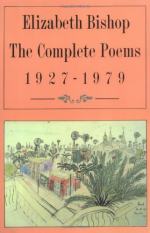
|
| Name: _________________________ | Period: ___________________ |
This test consists of 5 multiple choice questions, 5 short answer questions, and 10 short essay questions.
Multiple Choice Questions
1. How many stanzas does "One Art" have?
(a) 6.
(b) 8.
(c) 9.
(d) 7.
2. Stanzas four through six have which techniques in common?
(a) Second person and indicative mood.
(b) First person and imperative mood.
(c) Second person and imperative mood.
(d) First person and indicative mood.
3. Which word in lines 10 and 11, "And look! my last,/ or next-to-last, of three loved houses went," creates a momentary shift in verb mood?
(a) The word "look."
(b) The word "next."
(c) The word "went."
(d) The word "loved."
4. The relationship between stanza two and stanza three is most accurately expressed by which of the following?
(a) Stanza three repeats the emotional plea of stanza two in a more logical and rational form.
(b) Stanza three exposes the inherent contradictions in the ideas about loss advanced by stanza two.
(c) Stanza three extends the small, everyday losses in stanza two into more serious and personal territory.
(d) Stanza three provides hyperbolic examples of the effects of loss proposed in stanza two.
5. Which is the best description of the tone of stanza one?
(a) Sanguine.
(b) Livid.
(c) Ebullient.
(d) Bewildered.
Short Answer Questions
1. What does the second stanza suggest the "art" of losing consists of?
2. How many lines does "One Art" have?
3. What is the verb mood of line 4, "Lose something every day"?
4. What is used for the first time in the poem's final stanza?
5. In the first stanza, what does the speaker suggest makes the loss of some things especially easy to accept?
Short Essay Questions
1. How does the speaker arrange the examples of things that can be lost?
2. Which two verb moods are used in "One Art," and where are they employed?
3. How does the speaker's diction increase the emotional stakes as the poem progresses?
4. Describe the form of "One Art."
5. To whom is the parenthetical comment "(Write it!)" addressed in line 19, and how does this comment impact the reader's understanding of the poem?
6. How does the change in stanza structure in the final stanza mimic the poem's changing meaning?
7. What are the refrains employed in "One Art"?
8. What difference is there in the way the two refrain lines are repeated throughout the poem?
9. On the surface level, what is the main message of "One Art"?
10. What is the poem's dominant meter, and how is it regularly interrupted?
|
This section contains 907 words (approx. 4 pages at 300 words per page) |

|




